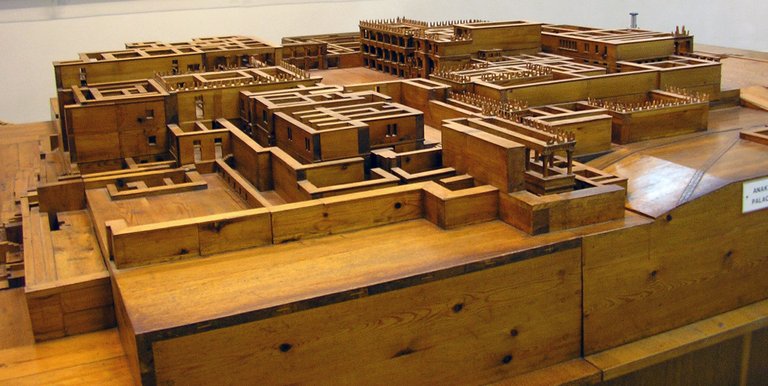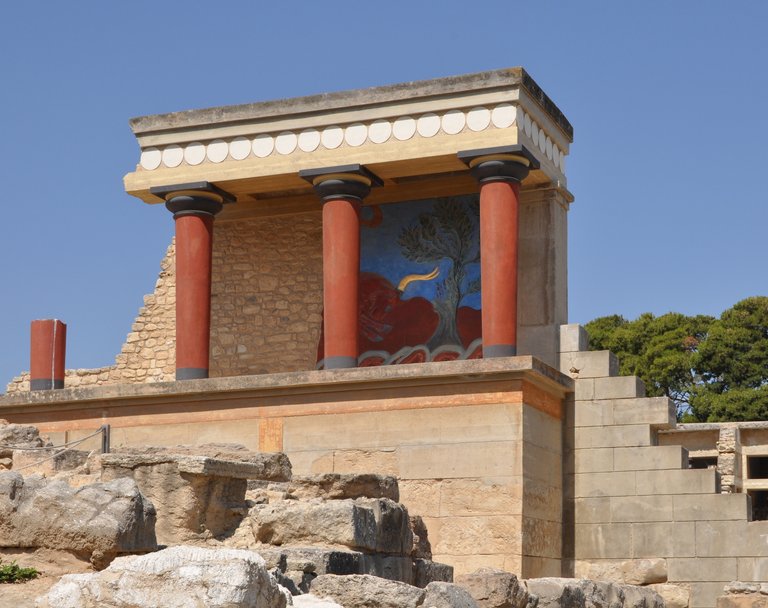In 1899, an amateur archaeologist purchased a piece of land at Heraklion on the island of Crete, just south of Greece.

The man in question was Sir Arthur Evans and he chose to do this after discovering a piece of writing in an unknown language he named 'Linear A'. He believed the writing originated from this island, so he purchased the land to excavate it in the hopes of finding answers. The timing was not so great as Crete was plunged into civil war when he arrived. However, he was determined to find something, therefore he continued his quest.
In the end, his perseverance paid off and through his and his team's efforts, a palace was unearthed. Along with this came the discovery of a new civilization. Evans named the civilization 'Minoan' after King Minos and the Minotaur because the palace resembled a labyrinth.
The Palace
Covering six acres, it was three storeys high and had hundreds of interlocking rooms - some to be personal chambers. Evans believed this was the seat of government but there is no evidence of a monarchy existing in this civilization. It was constructed out of brick and limestone with wood columns.

The original building revealed earthquake damage being that Crete was, and still is, susceptible to such natural disasters. By the time they began rebuilding, it was earthquake-proof. Their solution was to place wooden walls and fill them with stones to keep it from collapsing. There was even running water which allowed for the use of bathtubs and flushed toilets. In fact, the Minoan system of sanitation was only surpassed by the Romans.
There are writings of people visiting the palace and marveling it and being awed by the way it shined when sunlight touched it. It is possible that this was achieved through polished stone that was discovered at the site. Of course, these accounts were written by travelers visiting Crete since Linear A to this day remains untranslated.
The Minoans
The artifacts discovered reveal their civilization began in 4000 B.C. and peaked after 2,000 years. Due to the island's location, the Minoans acted as middlemen in trade. They traded far and wide and their crafts have been uncovered in places as far as Egypt. One thing that they traded was metalwork in a rare and advanced two-step process. First, they would travel outside of Crete to gather the raw material, then come back and turn it into a finished product.

The Minoans seemed to be happy and peaceful people based on Egyptian writings of them. Minoans had no organized religion as there is a lack of religious temples. However, there is evidence of human sacrifices performed. For instance, a house was discovered filled with children's bones. Another had a man that was tied up next to an alter with a dagger beside him, until an earthquake interrupted the ritual.
Unfortunately, in 1500 B.C., disaster struck. The end of the Minoan civilization is unknown but multiple theories mention it was either an earthquake, tidal wave, or volcano. However, the invasion of Mycenaeans from Greece around 1650 B.C. surely, in some way, played a part in its destruction.
The Legend
You've actually heard about the Minoans before reading this. Solon, a government official from Athens, visited Egypt. While he's there, he picks up the story of a sophisticated civilization where the name 'Crete' is used. He returns to Athens and shares the story, but replaces the name Crete with Atlantis. Atlantis then goes on to be a fictional island mentioned in Plato's works.

Even with the truth, the fantasy remains alive and well. Although the legacy of the Minoans was nearly forgotten after the Dark Age of Greece, their mark in history remains. Great effort is still being put into deciphering Linear A and, once it is, I look forward to the many fascinating things we will discover.

Good read. Thanks for posting.Cheers!!!!
Thanks a lot!
In reference to the ending, I'm always curious of what other historical artefacts are just sitting there, submerged in the water for hundreds of years just waiting to be found.
It's really exciting! Especially with new technology being developed!